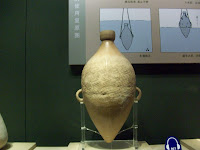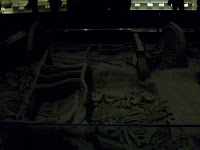We left the city wall and headed through the Xi'an city traffic on our way to lunch.
We noted the uniforms of the school girls.
Lunch was to be a Mongolian style 'Hot Pot' . Arrangements had been made for us at a downtown restaurant. We weaved our way through the crowded streets until we had reached our destination.
Hot pot is a winter favorite in China. The traditional Mongolian hot pot has been augmented by Cantonese and Sichuan/Szechwan-style hotpot. The ingredients for hot pots of different styles are mainly beef, mutton, seafood and vegetables. The boiling stock of Cantonese hotpot is light in taste, while the Sichuan hotpot features hot and spicy stock to enhance the flavor of the meat and vegetables. Diners choose their own selection of meat and vegetables and dip them into the boiling pot at their table.
It was not my favorite meal in China. I suppose with a little more instruction on how to use the hot-pots may have helped but even so...boiled meat is not at the top of my 'culinary delights' list. At any rate, lunch was over and it was time to continue on our journey. We left the restaurant, which was actually quite attractive, and reboarded the bus.

Next stop was the Shaanxi History Museum.
If you have any interest in Chinese history, then the Shaanxi Provincial Museum is a must when you are in Xian. One of the four largest museums in China (the others being the Forbidden City Museum, the Shanghai Museum [more here] and the Henan Provincial Museum). Tickets are free but you still need to get a reserve ticket. The museum is situated 1km northwest of the Big Wild Goose Pagoda. It is a huge architectural complex built in the Tang-dynasty style. It occupies an area of 70,000 square meters, and the construction area being more than 50,000 square meters. It focuses on the highlights of the Shaanxi culture and depicts the development of the Chinese civilization.
We followed our flag carrying guides, Henry and Henry II to the doors of the museum where they turned us loose to explore the displays.
Standing at guard in the entrance was a huge stone lion.
Behind the wall in back of the lion the historical displays awaited us.
Some of the artifacts, like this three legged pot and two entwined snakes, reminded me of Mayan artifacts that I had seem years earlier at the National Museum in Mexico City.
There were the obligatory replicas of the terracotta warriors,
And more...
And still more...
And here are a couple of short video clips inside the museum.
At first glance this looked like the ruins of a Chinese pyramid but it is actually the ruins of a military beacon tower on the Great Wall.
Near the end of the tour near the exit was a Buddha
in an intricately adorned alcove.
We waited outside in the grounds for everyone to exit before departing for our next adventure.
We would next be going the Muslim section of Xi'an near the Drum Tower where we would end our day and our time in Xi'an.
Next up, The Muslim Quarter of Xi'an.









































































No comments:
Post a Comment